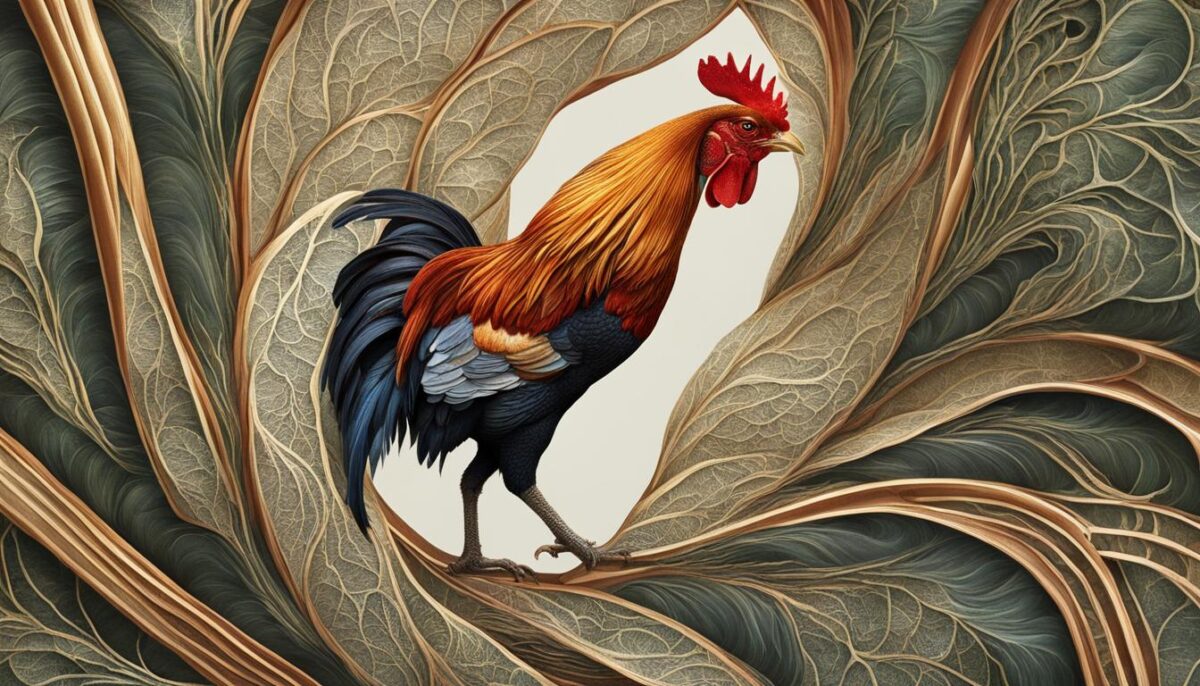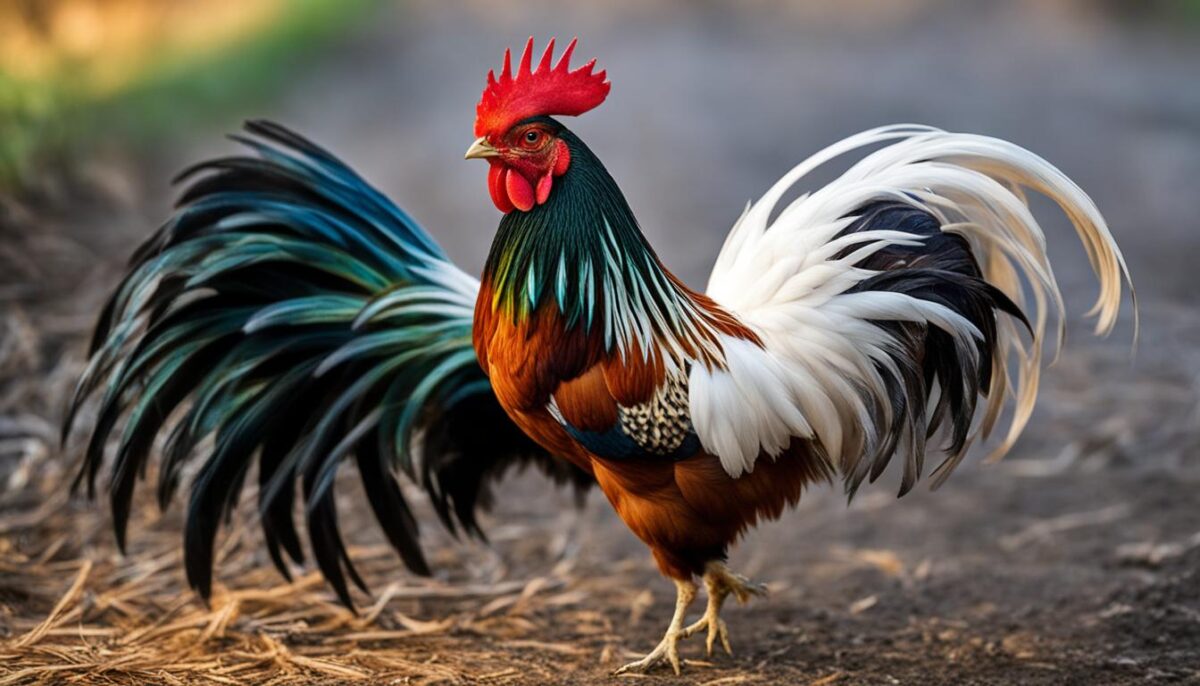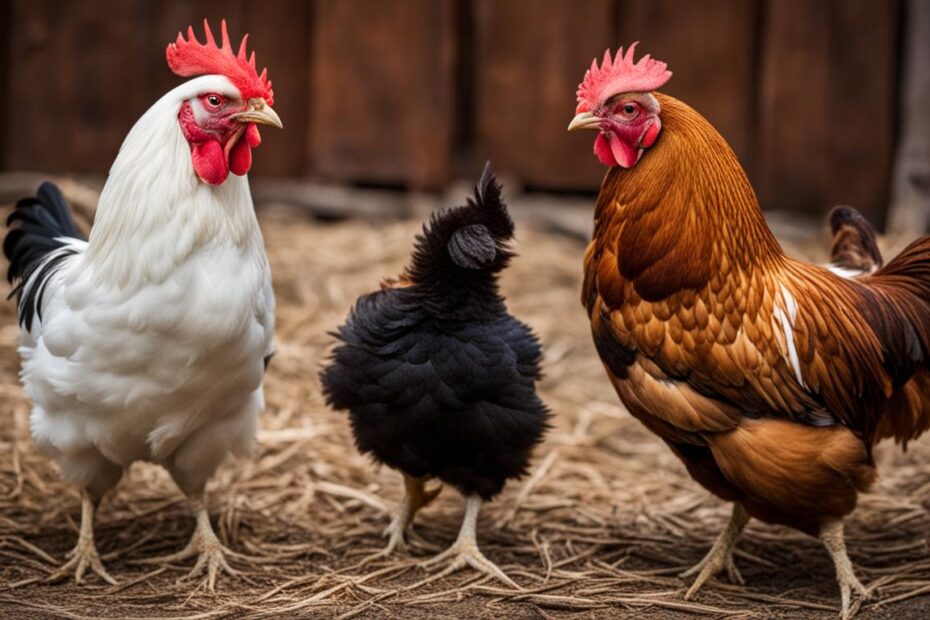Chickens, despite their lack of a visible penis, do engage in a unique reproductive process that involves mating between roosters and hens. The absence of the usual male appendage may make the mating process go unnoticed to the untrained eye. Let’s explore the fascinating world of chicken mating and reproduction.
Key Takeaways:
- Chickens have a unique reproductive process involving mating between roosters and hens.
- Roosters have various courting behaviors to attract hens and initiate mating.
- The mating process involves the touching of cloacas (vent areas) for the transfer of sperm from the rooster to the hen’s reproductive tract.
- Hens can lay eggs without mating, but only fertilized eggs are capable of hatching into chicks.
- Understanding chicken mating behavior can help maintain healthy flocks and improve breeding outcomes.
The Mating Rituals of Chickens
When it comes to chicken mating behavior, roosters have their own unique rituals to attract the attention of hens and initiate the mating process. These flamboyant displays often include wing displays, dancing in circles, and even enticing hens with food. The rooster, once successful in gaining the hen’s attention, mounts her by balancing on her back and holds her neck feathers while mating.
The mating process, also known as treading, involves the touching of the cloacas (vent areas) of both the rooster and hen, allowing for the transfer of sperm from the rooster to the hen’s reproductive tract. While this process may go unnoticed to the untrained eye due to the absence of a visible male appendage, it is a crucial step in the reproduction of chickens.
To better understand the mating rituals of chickens, it is important to familiarize ourselves with their unique reproductive anatomy. The rooster’s sexual organ, known as the papilla, is located inside his cloaca and serves the purpose of allowing semen to exit his body. In turn, the hen inverts her cloaca to meet the rooster’s papilla for the transfer of sperm during mating. This internal reproductive system is one of the distinct features that sets chickens apart from other animals.
Aside from mating, understanding the dynamics of rooster-hen relationships is key to maintaining a healthy flock. Roosters often exhibit various behaviors related to mating, including the chasing of hens and engaging in fights with other roosters to establish dominance. They can mate multiple times a day and have preferences for certain hens. It is important for breeders and chicken enthusiasts to be aware of these behaviors and take necessary precautions to ensure the well-being of their flock.
Table: Chicken Mating Rituals
| Mating Rituals | Description |
|---|---|
| Flamboyant Wing Displays | Roosters often display their wings in a flamboyant manner to attract the attention of hens. |
| Dancing in Circles | Roosters may engage in circular dancing movements as a courtship behavior. |
| Enticing Hens with Food | Roosters offer food as a way to entice hens and establish a connection. |
| Treading | The mating process involves the touching of cloacas to transfer sperm from the rooster to the hen. |
Anatomy of the Rooster’s Reproductive System
Understanding the reproductive anatomy of roosters is essential for comprehending their role in the mating process. Unlike mammals, roosters do not possess an external genital organ, such as a penis. Instead, their reproductive system is internal, with the sexual organ known as the papilla located within the cloaca.
The papilla is a small bump that serves as the exit point for semen in the rooster’s body. During mating, the rooster’s cloaca comes into contact with the hen’s cloaca, allowing for the transfer of sperm. This internal method of reproduction is unique to chickens and distinguishes them from other animals.

By having a closer look at the reproductive anatomy of roosters, we gain insight into their ability to successfully mate with hens. Despite not having external male reproductive parts, roosters have evolved a specialized internal system that enables them to contribute to the fertilization process, ensuring the continuation of their species.
The Act of Chicken Copulation
Chicken copulation involves a unique set of behaviors and positioning between the rooster and the hen. It begins with the rooster getting into a position that resembles a piggy-back ride on the hen’s back. The rooster holds onto the hen’s neck feathers with his beak and steadies himself with his feet. Meanwhile, the hen crouches down, spreads her wings for balance, and lowers her tail in a submissive squat. This positioning allows for the necessary contact between their reproductive organs.
During copulation, the rooster’s papilla, the small bump located inside his cloaca, makes contact with the hen’s reversed cloaca. This touch, often referred to as the “cloacal kiss,” facilitates the transfer of sperm from the rooster to the hen. The act of mating itself is relatively quick, and once complete, both the rooster and hen resume their normal activities.
To provide a visual representation of the copulation process, here is a table summarizing the key steps:
| Step | Description |
|---|---|
| 1 | Rooster gets into piggy-back position on the hen |
| 2 | Rooster holds onto hen’s neck feathers with his beak |
| 3 | Hen crouches down, spreads wings, and lowers her tail |
| 4 | Contact between rooster’s papilla and hen’s cloaca |
| 5 | Transfer of sperm from rooster to hen |
| 6 | Copulation completes, both rooster and hen resume normal activities |
The copulation process is an essential aspect of chicken reproduction, allowing for the fertilization of eggs. Understanding the intricacies of chicken mating behavior can help breeders and enthusiasts maintain healthy flocks and improve breeding outcomes.
Reproduction Without Mating
While mating is a crucial aspect of chicken reproduction, hens are capable of laying eggs without mating with a rooster. In fact, hens will continue to lay eggs with the same frequency whether or not there is a rooster present in the flock.
This process, known as parthenogenesis, allows hens to lay unfertilized eggs. These eggs do not contain embryos and therefore cannot hatch into chicks. However, if a rooster mates with a hen, the egg can be fertilized, leading to the development of a potential chick.
To put it simply, hens lay eggs regardless of whether or not they have had the opportunity to mate with a rooster. However, for a fertile egg capable of hatching into a chick, it must be fertilized by a rooster’s sperm.
| Reproduction Process | Mating with a Rooster | Laying Unfertilized Eggs |
|---|---|---|
| Description | The hen is fertilized by a rooster’s sperm, resulting in the development of a potential chick. | The hen lays eggs without mating, but these eggs will not develop into chicks. |
| Requirement | Requires mating with a rooster for fertilization. | Does not require mating for egg-laying, but the eggs will not develop into chicks without fertilization. |
| Fertility | The eggs have the potential to be fertile and develop into chicks. | The eggs are unfertilized and will not develop into chicks. |
So, while hens can lay eggs without mating, it is the presence of a rooster that determines whether or not those eggs have the potential to be fertile. Understanding this aspect of chicken reproduction is important for breeders and chicken enthusiasts looking to successfully hatch chicks.
Fertilization and Fertility in Chickens
Understanding the fertilization process is essential for chicken breeders and enthusiasts. Chickens have a unique reproductive system that involves the transfer of sperm from roosters to hens. After mating, the sperm travels through the hen’s reproductive tract to fertilize the egg in the oviduct. Sperm can remain viable for up to two weeks, increasing the chances of successful fertilization.
To ensure optimal fertility in a flock, it is recommended to maintain a ratio of eight to twelve hens per rooster. The fertility of roosters can vary, and having an appropriate number of hens per rooster helps ensure that each hen has a higher chance of being successfully fertilized. Different breeds may require different ratios depending on their size and breeding habits.
Some additional considerations to improve fertility include providing roosters with supplements like vitamins and electrolytes. These supplements can help improve their overall health and virility, leading to better mating success. Breeders may also choose to separate breeders for a certain period of time to control parentage and minimize the presence of inactive sperm before mating.
Table:
| Factors Influencing Fertility in Chickens | Recommendations |
|---|---|
| Rooster-to-hen ratio | Maintain a ratio of 8-12 hens per rooster |
| Rooster health and nutrition | Provide supplements like vitamins and electrolytes |
| Breeding pen setup | Isolate specific pairings for improved breeding outcomes |
| Separation before mating | Separate hens from multiple roosters for two weeks before mating |

Factors Influencing Fertility in Chickens
Several factors can influence the fertility of chickens. Maintaining an appropriate rooster-to-hen ratio is crucial for ensuring successful fertilization. Too few roosters may result in inadequate sperm availability, while too many may lead to excessive mating attempts and decreased fertility.
In addition to the number of roosters, their overall health and nutrition play a role in fertility. Providing roosters with supplements like vitamins and electrolytes can enhance their reproductive function and increase the likelihood of successful mating.
Proper breeding pen setup can also improve breeding outcomes. Isolating specific pairings allows breeders to control parentage and increase the chances of obtaining desired traits in the offspring. Separating hens from multiple roosters for a period of two weeks before mating eliminates the presence of inactive sperm, ensuring that only active and viable sperm can fertilize the eggs.
Hen-Specific Considerations
When it comes to hen mating behavior, there are a few considerations that poultry breeders should keep in mind. The act of mating, known as treading, can sometimes cause feather damage, bald spots, and even skin damage to hens. To protect them from these potential physical harms during mating, hens can wear cloth aprons known as Hen Mating Saddles™. These aprons act as protective garments and help prevent any harm to the hens’ feathers and skin.
In addition to potential physical damage, hens can also go broody even without the presence of a rooster. Broodiness refers to a hen’s desire to sit on her eggs and incubate them, in the hopes of hatching chicks. However, it’s important to note that only fertilized eggs will be capable of hatching. So, even if a hen goes broody, without mating with a rooster, the eggs she lays will not be fertile and therefore will not hatch into chicks.
Understanding hen mating behavior and these hen-specific considerations are essential for poultry breeders looking to maintain the health and well-being of their flock. By providing appropriate protection and understanding the intricacies of hen reproduction, breeders can ensure the overall welfare of their hens and optimize breeding outcomes.
Benefits of Hen Mating Saddles™
The use of Hen Mating Saddles™ can provide several benefits for hens during the mating process:
- Protection against feather damage and bald spots caused by treading
- Prevention of potential skin damage
- Reduced stress during mating
- Improved overall welfare and comfort for hens
| Saddle Design | Material | Available Sizes |
|---|---|---|
| Classic | Cotton | Small, Medium, Large |
| Deluxe | Waterproof nylon | Small, Medium, Large |
| Decorative | Various patterns | Small, Medium, Large |
Hen Mating Saddles™ provide crucial protection for hens during mating. Not only do they help prevent feather damage and bald spots, but they also contribute to overall welfare and comfort. Investing in these protective garments can greatly benefit the health and happiness of your flock.

Rooster-Hen Dynamics
Understanding the dynamics between roosters and hens is integral to maintaining a healthy and productive flock. Roosters not only play a vital role in the mating process but also serve as protectors, alerting the flock to potential threats and keeping watch over the hens. Their vigilant nature helps ensure the safety of the flock.
When introducing new roosters to an existing flock, it’s important to do so gradually to prevent aggressive behavior and territorial disputes. Isolating the new rooster in a separate area within sight of the hens can help them become accustomed to each other and minimize any potential conflicts. Monitoring their interactions closely and providing ample resources, such as food and water, can further reduce aggression and promote a harmonious coexistence.
Ultimately, understanding rooster behavior and maintaining a balanced dynamic within the flock is essential for successful mating and overall flock health. By providing proper care, monitoring behavior, and addressing any issues that arise, flock owners can ensure a thriving and productive flock of chickens.
Breeding Considerations
When it comes to chicken breeding, there are several key considerations that breeders should keep in mind. By understanding and implementing these breeding practices, breeders can improve the fertility of their roosters and enhance their breeding outcomes. Here are some important factors to consider:
Isolating Breeders
To control parentage and ensure desired genetic traits, it is important to isolate breeders. This involves separating hens and roosters for a period of time to eliminate the presence of inactive sperm. A two-week separation is generally recommended if a hen has been exposed to multiple roosters to ensure accurate parentage. By maintaining controlled breeding conditions, breeders can have better control over the characteristics and quality of their flock.
Setting Up Breeding Pens
Setting up breeding pens can be an effective way to improve breeding outcomes. Breeding pens allow breeders to isolate specific pairings and increase the chances of producing certain types of chicks. By carefully selecting which roosters are paired with which hens, breeders can focus on breeding for specific traits or breed standards. This method can be particularly useful for breeders looking to maintain and improve the quality of their flock.
Seasonal Considerations
The time of year can have an impact on rooster behavior and mating challenges. During the winter to spring period, roosters’ testosterone levels rise, which can lead to increased aggression and more frequent mating attempts. Breeders should be aware of these seasonal changes in behavior and take appropriate measures to manage and handle roosters during this time. By understanding the natural breeding patterns of chickens, breeders can optimize breeding strategies and improve overall fertility rates.
By following these breeding considerations, breeders can enhance the fertility of their roosters and achieve better breeding results. Whether for commercial purposes or hobby breeding, understanding the intricacies of breeding can lead to healthier flocks and more successful breeding outcomes.
| Consideration | Description |
|---|---|
| Isolating Breeders | Separate hens and roosters to control parentage and eliminate inactive sperm. |
| Setting Up Breeding Pens | Isolate specific pairings in breeding pens to focus on desired traits. |
| Seasonal Considerations | Be aware of roosters’ behavior changes and mating challenges during specific seasons. |
Conclusion
After exploring the fascinating world of chicken reproduction, it is clear that chickens do indeed have sex. Although the process differs from that of mammals, roosters and hens engage in unique mating rituals that allow for successful fertilization.
Roosters, despite lacking a penis, use their internal reproductive anatomy to mate with hens. The act of treading, where the rooster mounts the hen and touches cloacas, allows for the transfer of sperm. Hens, on the other hand, are capable of laying eggs without mating, but only fertilized eggs have the potential to hatch into chicks.
Understanding the intricacies of chicken mating behavior and reproductive anatomy is important for breeders and chicken enthusiasts. It can help maintain healthy flocks and improve breeding outcomes. From the rooster’s courting behaviors to the hen’s ability to lay unfertilized eggs, every aspect plays a significant role in the chicken reproduction process.
So, the next time someone asks if chickens have sex, you can confidently answer in the affirmative. Chickens may have their own unique way of reproducing, but they definitely engage in the essential act of mating.
FAQ
Do chickens have sex?
Yes, chickens engage in mating behavior to reproduce.
What are the mating rituals of chickens?
Mating rituals of chickens include roosters displaying flamboyant wing displays, dancing, and enticing hens with food to attract their attention.
What is the anatomy of the rooster’s reproductive system?
The rooster’s reproductive organ, called the papilla, is located internally in the cloaca, allowing for the transfer of sperm during mating.
How do chickens copulate?
Chickens copulate by the rooster mounting the hen, holding onto her neck feathers with his beak, and the transfer of sperm occurs through the touching of cloacas.
Can hens lay eggs without mating?
Yes, hens can lay eggs without mating, but these eggs will not be fertile and cannot hatch into chicks.
How does fertilization and fertility work in chickens?
Fertilization in chickens occurs when a rooster’s sperm fertilizes a hen’s egg in the oviduct. Rooster fertility can vary, and having an appropriate rooster-to-hen ratio is important for adequate fertility in the flock.
What considerations are there for hens during mating?
Hens can wear cloth aprons known as Hen Mating Saddles™ to protect them from physical harm during mating. Hens can go broody without a rooster present, but only fertilized eggs will be capable of hatching.
What is the behavior of roosters and the dynamics with hens during mating?
Roosters may exhibit aggressive behaviors, such as chasing hens and engaging in fights with other roosters. They can mate multiple times a day and have preferences for certain hens.
What considerations should be made for breeding chickens?
Breeding chickens requires careful isolation of breeders to control parentage. A two-week separation is recommended if a hen has been exposed to multiple roosters. Breeding pens can be set up to isolate specific pairings and improve breeding outcomes.
How does the chicken reproduction process work?
Understanding the intricacies of chicken mating and reproduction can help maintain healthy flocks and improve breeding outcomes.


